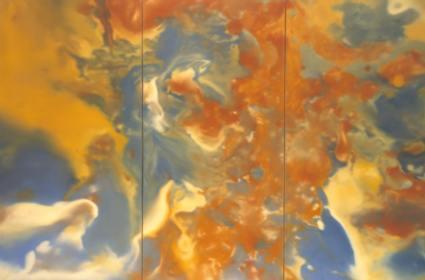Gerhard Richter
dal 16/1/2004 al 31/3/2004
Segnalato da
16/1/2004
Gerhard Richter
Contemporary Art Centre, Malaga
Within the present exhibition, the emphasis is on Richter's paintings based on photographs, his pure paintings, his famous grisailles and in particular the abstract expressionist works. In each one Richter reveals his virtuoso abilities with regard to a pictorial language which he uses in an extraordinary manner to work in a wide range of different genres such as landscape, the portrait and geometrical compositions.

The CAC Malaga is presenting a retrospective exhibition shown for the first time
in Spain and devoted to the work of Gerhard Richter, considered by many to be
the most important artist of the second half of the 20th century. It brings
together a total of 30 works created by Richter (born in Dresden in 1932)
between 1960 and 2003. Together they offer a unique survey of this remarkable
German artist's work, once again proving that the notion of style cannot
appropriately be applied to his oeuvre. In this sense, the exhibition's
curator Juergen Schilling has noted: 'Art historians' categories, which aim
to place his work within specific trends by the use of stylistic labels, have
not worked due to his polymorphism, often arising from crisis'.
Within the present exhibition, the emphasis is on Richter's paintings based on
photographs, his pure paintings, his famous grisailles and in particular the
abstract expressionist works. In each one Richter reveals his virtuoso abilities
with regard to a pictorial language which he uses in an extraordinary manner to
work in a wide range of different genres such as landscape, the portrait and
geometrical compositions.
Throughout his career, Richter's work has been distinguished by his command of
both figuration and abstraction. His work stood out in a climate in which
painting was considered by many to be obsolete, exhausted and destined to
disappear in the face of the new image-making technologies.
Beginnings
Born in 1932, after World War II Richter remained in East Germany, where he
studied at the Dresden Fine Arts Academy. His early works include a number of
murals on political subjects. Richter's first visits to West Germany allowed
him to make contact with new artistic trends such as Abstract Expressionism and
Informalism.
In 1961, shortly after the Berlin Wall came down, Richter moved permanently to
West Germany and was accepted at the Dusseldorf Art Academy, where he
discovered the work of Jean Dubuffet, Alberto Giacometti, Jean Fautrier and the
experiments of the Fluxus group, a Dadaist revival. For a while the artist was
associated with Capital Realism, a short-lived trend linked to Pop Art which
described the situation in Post-War Germany from a satirical viewpoint.
Photography as starting-point
Richter abandoned Informalism in 1962 and began on his first works based on
projected photographs. This is the period of his celebrated grisailles,
resulting from the fact that most of the photographs which he used were in black
and white, taken from newspapers and magazines (pornographic and otherwise),
advertising brochures, portraits of unknown figures and of artists taken from
the press. This is the period of Waldstuck (Piece of Forest, 1965), Liebespaar
in Wald (Lovers in the Forest, 1966), Olympia (1967) and Portrait Liz Kertelge
(Portrait of Liz Kertelge, 1966). Among the portraits is the one of Brigid Polk
(1971), one of the leading figures in Andy Warhol's Factory in New York,
depicted five times in total.
At the same time that he was producing these photography-based works and
demonstrating that his work could not be classified in a linear manner, Richter
created a new group of works clearly influenced by Pop Art in which colour
played the key role. An excellent example included in the exhibition is Sechs
Farben (Six Colours, 1966). From 1969 onwards, landscape began to prevail in the
artist's work, a genre that he has continued to work in regularly to the
present day and represented here by works from a private collection such as
Wilhelmshaven (1969), Brucke am Meer (Bridge over the Sea, 1969), Seestuck
(Marine View, 1969) and Stadtbild PL (Urban Landscape, 1970), the last radically
different to the previous works both in the perspective and technique deployed.
Richter's use of colour
Richter's interest in colour is evident in paintings such as Ausschnitt
(Detail, 1971), based on the amplification of the chromatic combinations of the
oil paint on the artist's palette, and Grau (Grey, 1976). According to the
artist, in these monochromatic grey canvases he is looking for 'the only and
ideal correspondence possible for indifference, negation of the message and lack
of form'.
Richter created his first abstract painting, Konstruktion (Construction, 1976)
when he was still painting his grisailles. It is notably different in technique
and handling to his later abstractions, represented in the present exhibition by
Pavillon (Pavilion, 1982), Eule (Owl, 1892) and Ingrid (1984).
This interest in abstraction did not prevent the artist from also working in a
figurative mode. The result is landscapes such as Krems (1986), still lifes such
as Blumen (Flowers, 1994), and enigmatic paintings of candles and skulls that
recall Baroque 'vanitas' symbolism, for example Schaidel mit Kerze (Skull
with Candle, 1983).
With regard to the future of painting, Richter himself has said:
'...everything has already been represented in the history of art long ago and
the new technologies of communication, video, performance, etc, can convey it
all according to the times we live in. Nonetheless, pleasure is a proof of the
necessity for painting. All children paint spontaneously. Painting has a
marvellous future, doesn't it?''
Contemporary Art Centre of Malaga
Malaga
Calle Alemania s/n
Telf: + 34 952 120055
Fax: + 34 952 210177



